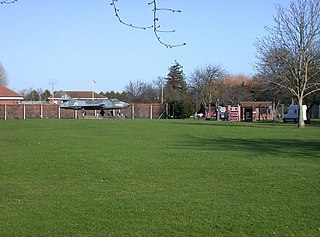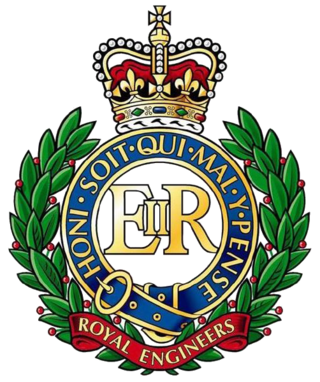
The Royal Corps of Signals is one of the combat support arms of the British Army. Signals units are among the first into action, providing the battlefield communications and information systems essential to all operations. Royal Signals units provide the full telecommunications infrastructure for the Army wherever they operate in the world. The Corps has its own engineers, logistics experts and systems operators to run radio and area networks in the field. It is responsible for installing, maintaining and operating all types of telecommunications equipment and information systems, providing command support to commanders and their headquarters, and conducting electronic warfare against enemy communications.

Royal Air Force Wittering or more simply RAF Wittering is a Royal Air Force station within the unitary authority area of Peterborough, Cambridgeshire and the unitary authority area of North Northamptonshire. Although Stamford in Lincolnshire is the nearest town, the runways of RAF Wittering cross the boundary between Cambridgeshire and Northamptonshire.
Royal Air Force Bramcote, or more simply RAF Bramcote, is a former Royal Air Force station located 3.5 miles (5.6 km) south-east of Nuneaton, Warwickshire, England used during the Second World War. It was later transferred to the Admiralty and was known as Royal Naval Air Station Bramcote,, and when commissioned became HMS Gamecock. When it subsequently transferred to the British Army from the Admiralty, it was called Gamecock Barracks.

The Kent Fortress Royal Engineers (KFRE) was a volunteer Territorial unit of the British Army that saw service in both World Wars. They are notable for their successful actions in May 1940, when they destroyed substantial oil stocks and installations just ahead of the German advance, and in August 1944 during the assault crossing of the River Seine.
Gamecock Barracks is a British Army installation located at Bramcote, 3.5 miles (5.6 km) south-east of Nuneaton in Warwickshire.

Royal Air Force Waterbeach or more simply RAF Waterbeach is a former Royal Air Force station located in Waterbeach, Cambridgeshire which is about 5.5 miles (8.9 km) north of Cambridge, England. The site was transferred to the Royal Engineers, part of the British Army, in 1966, as Waterbeach Barracks.

Waterbeach Barracks was a military installation in Waterbeach, Cambridgeshire. The site was an RAF Station, RAF Waterbeach and then used by the Royal Engineers, part of the British Army, from 1966, until 2013 when the site closed to make way for housing.

8th Engineer Brigade is an engineering support formation of the British Army, under the command of HQ Allied Rapid Reaction Corps, supporting NATO.

The page contains the current structure of the British Army. The British Army is currently being reorganised to the Future Soldier structure.
This is a list of units of the British Army's Royal Engineers.
The following is a hierarchical outline for the structure of the British Army in 1989. The most authoritative source for this type of information available is Ministry of Defence, Master Order of Battle, and United Kingdom Land Forces, HQ UKLF, UKLF ORBAT Review Action Plan, HQ UKLF, 1990.

The 29 Group, formerly 29 Engineer Brigade, is an engineer formation of the British Army responsible for Explosive Ordnance Disposal and Search. Its headquarters were at Aldershot, now at Didcot.
1 Signal Regiment is a military communications regiment of the British Army. The regiment is now part of the 11th Signal Brigade.

12 Engineer Group is an engineer formation of the British Army.

7th Air Defence Group is a formation of the British Army under the command of HQ Allied Rapid Reaction Corps. It provides all of the United Kingdom's ground based air defence assets. The organisation's subordinate units are drawn from the Royal Regiment of Artillery. The headquarters are located at Baker Barracks, Thorney Island.

The East Lancashire Royal Engineers was a Volunteer unit of Britain's Royal Engineers raised in Manchester in 1901. It became the engineer component of the 42nd Division of the Territorial Force, seeing service in Egypt, at Gallipoli and on the Western Front during the First World War. In the Second World War, it took part in the Dunkirk evacuation with 42nd Division, and then converted to the armoured assault engineer role in 79th Armoured Division in North West Europe. Its duplicate unit served in Tunisia and Italy. The unit continues today as part of 75 Engineer Regiment in the Army Reserve.

58 Field Squadron is currently an Explosive Ordnance Disposal (EOD) unit of the Royal Engineers (RE). In its long history its predecessors have fulfilled the roles of artisans, field engineers, chemical warfare specialists, and road builders. They saw active service on the Western Front in World War I and in the Battle of France and Burma Campaign during World War II. On two occasions, the unit's sappers were reputed to have repulsed enemy attacks at the point of the bayonet.

The 1st Field Engineer Squadron is an engineer unit of the Corps of Royal Engineers within the British Army. The squadron was first formed in 1914 following the mobilisation of the Army for the First World War. The squadron later supported The Cavalry Division and the first British Army of the Rhine. The squadron later saw service in the Second World War and today supports the 21st Engineer Regiment of the new 1st Strike Brigade.

The 10th Railway Engineer Squadron, known operationally as 10 RW Squadron. The squadron was first formed during the pre-war expansion of the army in 1939 just before Second World War. The squadron was finally disbanded in 2013 following the initial Army 2020 reforms.

224 Signal Squadron (Cyber) is a company sized military communications unit of the British Army's Royal Corps of Signals and forms part of the corps' new 13th (Cyber) Signal Regiment. The squadron was originally formed in 1959 as part of the army's wider expansion of the Royal Signals, but disbanded in 1980 afters its tasks were taken over by a joint communications training group. In 2020, the squadron was reformed as part of the June 2020 reorganisation of the corps.













